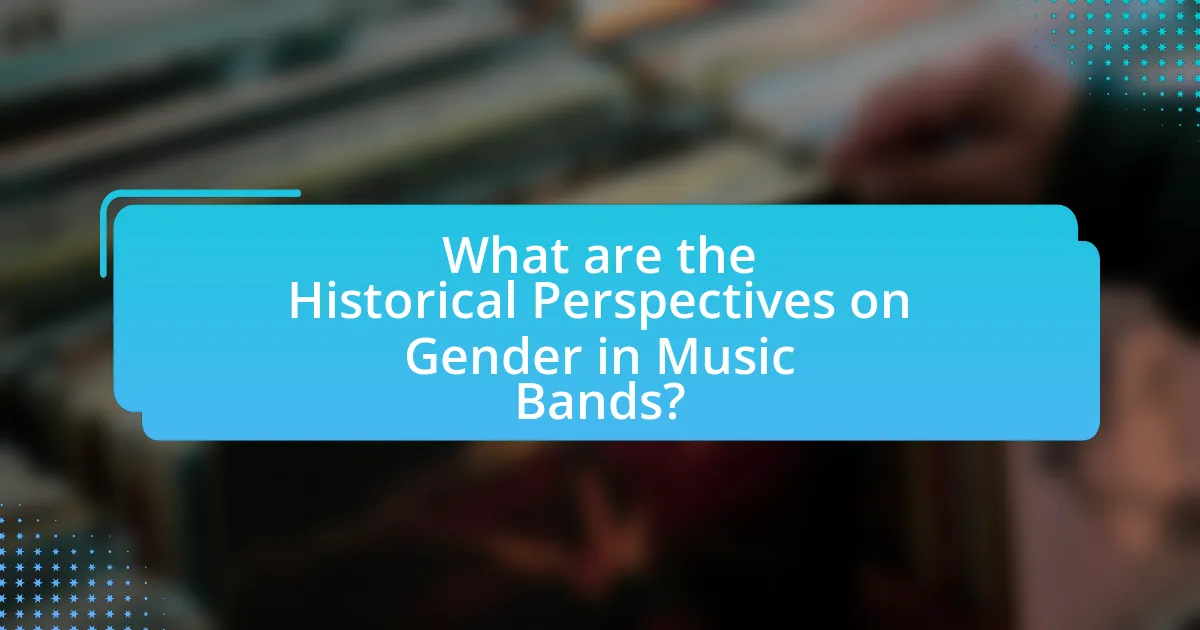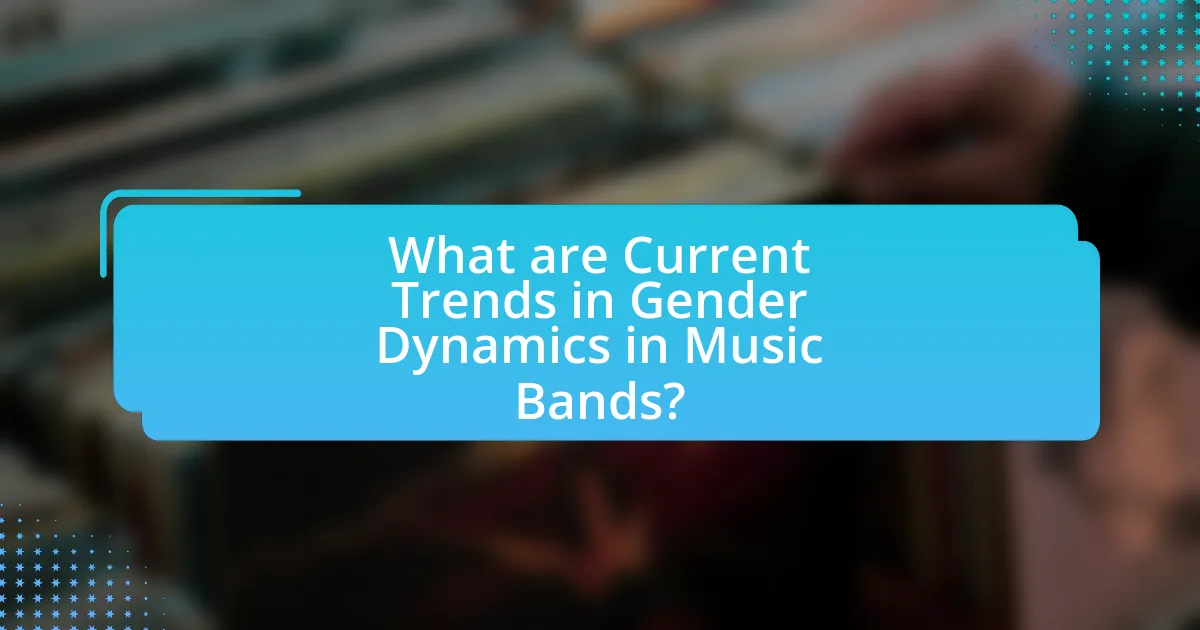The article explores gender dynamics in music bands, focusing on the interactions and relationships between different genders within musical collaboration and performance. It highlights the challenges faced by female musicians, including underrepresentation, gender bias, and stereotypes, which impact their roles and recognition in the industry. The article examines how these dynamics manifest in band structures, the historical evolution of gender roles, and the current trends promoting inclusivity. Additionally, it discusses the importance of understanding gender dynamics for fostering equitable environments and enhancing creativity within music groups.

What are Gender Dynamics in Music Bands?
Gender dynamics in music bands refer to the interactions and relationships between different genders within the context of musical collaboration and performance. These dynamics can influence roles, representation, and power structures within bands, often reflecting broader societal norms and expectations. For instance, research indicates that female musicians frequently face challenges such as underrepresentation, gender bias, and stereotypes that can affect their participation and recognition in the music industry. A study by the USC Annenberg Inclusion Initiative found that only 22.5% of artists across popular music genres were women, highlighting significant gender disparities. Additionally, the dynamics can vary widely depending on the genre, with some genres being more inclusive than others.
How do gender dynamics manifest in music bands?
Gender dynamics in music bands manifest through the roles, representation, and interactions of male and female members. In many bands, male musicians often dominate leadership positions, influencing creative decisions and public perception, while female musicians frequently face challenges related to visibility and recognition. For instance, a study by the USC Annenberg Inclusion Initiative found that only 22.5% of artists across the top 600 songs from 2012 to 2017 were female, highlighting the gender disparity in the industry. Additionally, female musicians often encounter stereotypes that can limit their artistic expression and opportunities, such as being typecast into specific genres or roles. These dynamics not only affect the internal functioning of bands but also shape the broader cultural narratives surrounding music and gender.
What roles do different genders typically occupy in music bands?
In music bands, different genders typically occupy distinct roles, with men often taking on instrumental positions such as guitarists, drummers, and bassists, while women frequently occupy roles as vocalists or keyboardists. This trend is supported by various studies, including a 2019 analysis by the USC Annenberg Inclusion Initiative, which found that male musicians dominate instrumental roles in popular music, comprising over 70% of band members. Conversely, women are more likely to be featured as lead singers, reflecting societal norms and expectations regarding gender in the music industry.
How do gender dynamics influence band dynamics and creativity?
Gender dynamics significantly influence band dynamics and creativity by shaping interpersonal relationships, communication styles, and collaborative processes within the group. Research indicates that mixed-gender bands often experience a broader range of perspectives, which can enhance creativity and innovation in songwriting and performance. For instance, a study published in the Journal of Popular Music Studies found that bands with diverse gender representation reported higher levels of creative output and satisfaction among members. This diversity fosters an environment where different ideas and approaches are valued, leading to more dynamic musical expressions. Additionally, gender dynamics can affect power structures within bands, influencing decision-making processes and the distribution of roles, which ultimately impacts the overall creative direction of the group.
Why is it important to study gender dynamics in music bands?
Studying gender dynamics in music bands is important because it reveals how gender influences roles, interactions, and opportunities within musical groups. Research indicates that gender dynamics can affect everything from decision-making processes to the representation of women in various genres, with studies showing that female musicians often face barriers to entry and recognition in predominantly male spaces. For instance, a study published in the Journal of Popular Music Studies found that women in rock bands frequently encounter challenges related to sexism and stereotyping, which can hinder their creative expression and career advancement. Understanding these dynamics is crucial for fostering inclusivity and equity in the music industry.
What impact do gender dynamics have on the music industry?
Gender dynamics significantly impact the music industry by influencing representation, opportunities, and creative expression. Women and non-binary individuals often face barriers such as gender bias, underrepresentation in leadership roles, and unequal pay, which can limit their participation and visibility in the industry. For instance, a 2021 report by the Annenberg Inclusion Initiative found that only 22.5% of artists on the Billboard Hot 100 were women, highlighting the gender disparity in mainstream music. Furthermore, gender dynamics shape the narratives and themes present in music, as diverse perspectives contribute to richer storytelling and innovation in the art form.
How can understanding gender dynamics improve band collaboration?
Understanding gender dynamics can significantly improve band collaboration by fostering an inclusive environment that values diverse perspectives. When band members recognize and address gender-related issues, they can enhance communication, reduce conflicts, and promote creativity. Research indicates that diverse teams, including those with balanced gender representation, often outperform homogeneous groups in problem-solving and innovation. For instance, a study published in the Harvard Business Review found that gender-diverse teams are 15% more likely to outperform their counterparts. By leveraging the strengths of all members, bands can create a more cohesive and productive collaborative atmosphere.

What are the Historical Perspectives on Gender in Music Bands?
Historical perspectives on gender in music bands reveal a significant gender imbalance, with male musicians historically dominating the industry. In the early 20th century, women often faced barriers to entry in bands, particularly in genres like jazz and rock, where male musicianship was celebrated. For instance, female jazz musicians like Billie Holiday and Ella Fitzgerald broke through in the 1930s and 1940s, yet they often encountered sexism and limited opportunities compared to their male counterparts.
By the 1960s and 1970s, the feminist movement began to influence music, leading to the emergence of all-female bands such as The Runaways and The Go-Go’s, which challenged traditional gender roles. Despite this progress, women in music bands continued to face challenges, including underrepresentation in leadership roles and media coverage.
Research indicates that as of 2020, women made up only 21% of artists in the Billboard Hot 100, highlighting ongoing disparities. This historical context underscores the evolving yet persistent gender dynamics within music bands, illustrating both progress and the need for continued advocacy for gender equality in the music industry.
How have gender roles in music bands evolved over time?
Gender roles in music bands have evolved significantly from the mid-20th century to the present day. Initially, music bands were predominantly male-dominated, with women often relegated to supporting roles or excluded entirely from certain genres, such as rock and jazz. However, the feminist movements of the 1960s and 1970s began to challenge these norms, leading to the emergence of female-fronted bands and increased visibility for women in music.
By the 1990s and 2000s, the landscape shifted further as women began to take on leadership roles, not only as performers but also as songwriters, producers, and industry executives. For instance, artists like Alanis Morissette and Fiona Apple gained prominence, showcasing women’s perspectives and experiences in their music.
Recent studies indicate that the representation of women in music has continued to grow, with data from the Annenberg Inclusion Initiative revealing that women comprised 22.5% of artists in the top 600 songs from 2012 to 2019, a notable increase from previous decades. This evolution reflects broader societal changes regarding gender equality and has led to a more diverse and inclusive music scene.
What significant milestones have marked changes in gender representation in music bands?
Significant milestones that have marked changes in gender representation in music bands include the emergence of all-female bands in the 1960s, such as The Shirelles and The Ronettes, which challenged the male-dominated music industry. The 1990s saw a rise in female-fronted bands like No Doubt and The Cranberries, further shifting perceptions of women’s roles in music. Additionally, the 2010s brought increased visibility for women in genres like rock and hip-hop, exemplified by bands such as Haim and artists like Lizzo, who advocate for gender equality. These milestones reflect a broader cultural shift towards inclusivity and representation in the music industry.
How have societal changes influenced gender dynamics in music bands?
Societal changes have significantly influenced gender dynamics in music bands by promoting greater inclusivity and representation of women and non-binary individuals. The feminist movements of the 1960s and 1970s challenged traditional gender roles, leading to increased visibility of female musicians and the formation of all-female bands, such as The Runaways and The Go-Go’s. Additionally, the rise of social media has allowed diverse voices to gain recognition, enabling bands with varied gender compositions to reach wider audiences. According to a 2021 study by the USC Annenberg Inclusion Initiative, women comprised only 21.6% of artists in popular music, highlighting ongoing disparities but also indicating a gradual shift towards more equitable representation. These societal changes have reshaped the landscape of music bands, fostering environments where gender diversity is increasingly valued and celebrated.
What challenges have women faced in music bands historically?
Women in music bands have historically faced significant challenges, including gender discrimination, lack of representation, and societal stereotypes. Gender discrimination has often manifested in the form of limited access to opportunities, with women frequently being excluded from prominent roles within bands and the music industry. For instance, a study by the University of Southern California found that only 22% of artists on the Billboard Hot 100 were women, highlighting the systemic barriers they encounter.
Additionally, women have often been subjected to stereotypes that question their musical abilities and assert that they should conform to traditional gender roles. This has led to a lack of support and recognition for their contributions, as evidenced by the underrepresentation of women in music awards and festivals. Furthermore, women in bands have reported facing harassment and a hostile environment, which can deter them from pursuing careers in music. These challenges illustrate the complex dynamics women navigate within the music industry.
What barriers to entry have women encountered in the music industry?
Women in the music industry have encountered several barriers to entry, including gender bias, lack of representation, and limited access to resources. Gender bias manifests in the form of stereotypes that question women’s musical abilities and leadership skills, often leading to fewer opportunities for women in key roles such as producers, engineers, and executives. According to a 2021 report by the Annenberg Inclusion Initiative, women comprised only 21.6% of artists across the top 100 songs in 2020, highlighting the significant underrepresentation. Additionally, women often face challenges in networking and mentorship, which are crucial for career advancement in the industry. These barriers collectively hinder women’s ability to establish and sustain successful careers in music.
How have stereotypes affected women’s participation in music bands?
Stereotypes have significantly limited women’s participation in music bands by perpetuating the belief that certain instruments and roles are inherently masculine. This has resulted in fewer opportunities for women to join bands, as they often face biases that question their musical abilities and commitment. For instance, a study published in the Journal of Popular Music Studies found that women are often discouraged from playing instruments like electric guitar or drums, which are stereotypically viewed as male domains. Additionally, women musicians frequently encounter challenges such as being objectified or not taken seriously, which further hinders their involvement in band settings. These stereotypes create an environment that discourages female musicians from pursuing their interests and achieving equal representation in the music industry.

What are Current Trends in Gender Dynamics in Music Bands?
Current trends in gender dynamics in music bands show an increasing presence of women and non-binary individuals in various genres, challenging traditional male-dominated structures. Research indicates that female representation in bands has risen significantly, with a 2021 study by the Annenberg Inclusion Initiative revealing that women comprised 22.5% of artists in popular music, a notable increase from previous years. Additionally, the rise of all-female bands and mixed-gender collaborations reflects a shift towards inclusivity and diversity, as seen in the success of groups like Haim and CHVRCHES. This trend is further supported by initiatives aimed at promoting gender equality in the music industry, such as the #MeToo movement and organizations advocating for women’s rights in music.
How are contemporary music bands addressing gender dynamics?
Contemporary music bands are addressing gender dynamics by actively promoting gender equality within their groups and advocating for representation in the music industry. Many bands now feature diverse lineups that include women and non-binary members, challenging traditional gender roles. For instance, bands like Haim and CHVRCHES not only showcase female musicians but also address gender issues in their lyrics and public statements, raising awareness about sexism and inequality in the music scene. Additionally, initiatives such as the “Women in Music” organization provide resources and support for female artists, further emphasizing the importance of gender equity in contemporary music.
What initiatives are being taken to promote gender equality in music bands?
Initiatives to promote gender equality in music bands include programs aimed at increasing female representation, mentorship opportunities, and awareness campaigns. Organizations like Women in Music and the Keychange initiative actively work to create equitable opportunities for women in the music industry, advocating for a 50/50 gender balance in lineups and decision-making roles. Research by the Annenberg Inclusion Initiative highlights that only 22% of artists in popular music are women, underscoring the need for these initiatives to address systemic barriers and foster inclusivity.
How are social media and technology influencing gender dynamics in music bands?
Social media and technology are reshaping gender dynamics in music bands by providing platforms for diverse voices and facilitating greater visibility for female and non-binary musicians. This shift is evidenced by the rise of social media campaigns like #MeToo and #WomenInMusic, which have highlighted gender inequality and empowered underrepresented artists. Additionally, technology enables independent music production and distribution, allowing women to bypass traditional industry gatekeepers, as seen in the increasing number of female-led bands and solo artists gaining popularity through platforms like Spotify and YouTube. These changes contribute to a more equitable music landscape, challenging historical gender norms within the industry.
What role do male allies play in supporting gender dynamics in music bands?
Male allies play a crucial role in supporting gender dynamics in music bands by actively promoting inclusivity and challenging gender biases. Their involvement can help create a more equitable environment, as studies show that male allies can influence group dynamics positively, leading to increased collaboration and respect among band members. For instance, research published in the Journal of Music and Gender Studies highlights that male musicians who advocate for their female counterparts contribute to a culture that values diverse perspectives, ultimately enhancing creativity and performance quality.
How can male musicians contribute to a more inclusive environment?
Male musicians can contribute to a more inclusive environment by actively promoting gender equality and supporting female artists. They can do this by advocating for equal opportunities in performances, collaborations, and songwriting credits, which helps to dismantle systemic barriers that women face in the music industry. Research indicates that diverse teams lead to more innovative outcomes; for instance, a study by McKinsey & Company found that companies with higher gender diversity are 21% more likely to outperform their peers in profitability. By using their platforms to amplify underrepresented voices and participating in initiatives that address gender disparities, male musicians can foster a culture of inclusivity that benefits the entire music community.
What are examples of successful collaborations between genders in music bands?
Successful collaborations between genders in music bands include Fleetwood Mac, which features male and female members contributing to songwriting and vocals, resulting in iconic albums like “Rumours.” Another example is the band Paramore, where Hayley Williams and male bandmates create a blend of pop-punk and alternative rock, leading to multiple Grammy nominations. Additionally, the duo of Sheryl Crow and Kid Rock produced the hit “Picture,” showcasing a successful partnership that topped charts. These collaborations demonstrate the positive impact of gender diversity in music, enhancing creativity and broadening audience appeal.
What practical steps can music bands take to improve gender dynamics?
Music bands can improve gender dynamics by implementing inclusive hiring practices, ensuring equal representation in decision-making roles, and fostering a supportive environment. Inclusive hiring practices involve actively seeking diverse talent and creating job postings that encourage applications from all genders. Equal representation in decision-making roles can be achieved by including women and non-binary individuals in leadership positions, which has been shown to enhance creativity and innovation within teams. Fostering a supportive environment includes establishing clear policies against harassment and discrimination, as well as providing training on gender sensitivity. Research indicates that diverse teams perform better, with a McKinsey report highlighting that companies in the top quartile for gender diversity are 21% more likely to outperform their peers in profitability.
How can bands create a more inclusive culture?
Bands can create a more inclusive culture by actively promoting diversity in their lineup and decision-making processes. This involves intentionally recruiting members from various backgrounds, including different genders, ethnicities, and sexual orientations, which can enhance creativity and broaden perspectives. Research indicates that diverse teams are more innovative; for example, a study by McKinsey & Company found that companies with higher diversity levels are 35% more likely to outperform their peers in profitability. Additionally, bands can foster an inclusive environment by establishing clear policies against discrimination and harassment, ensuring that all members feel safe and valued. Implementing regular training on inclusivity and cultural sensitivity can further reinforce this commitment, leading to a more cohesive and supportive group dynamic.
What best practices should bands adopt to ensure gender equality?
Bands should adopt practices such as implementing equitable hiring policies, promoting diverse representation, and fostering an inclusive environment to ensure gender equality. Equitable hiring policies involve actively seeking female musicians and crew members, which can be supported by statistics showing that diverse teams enhance creativity and performance. Promoting diverse representation on stage and in promotional materials helps challenge stereotypes and encourages broader audience engagement. Additionally, fostering an inclusive environment through regular training on gender sensitivity and creating safe spaces for all members can lead to a more supportive atmosphere, as evidenced by studies indicating that inclusive workplaces improve overall team dynamics and productivity.

















